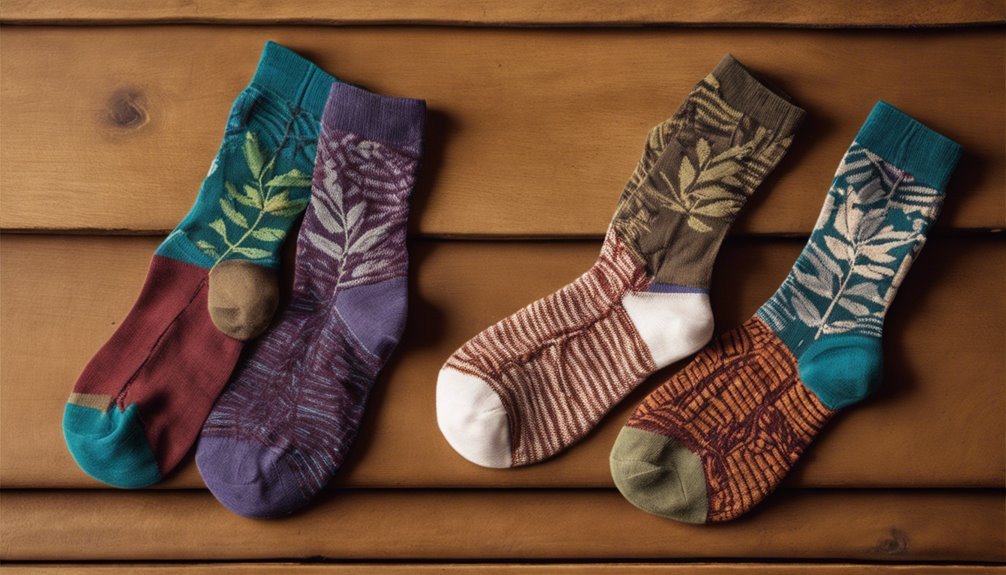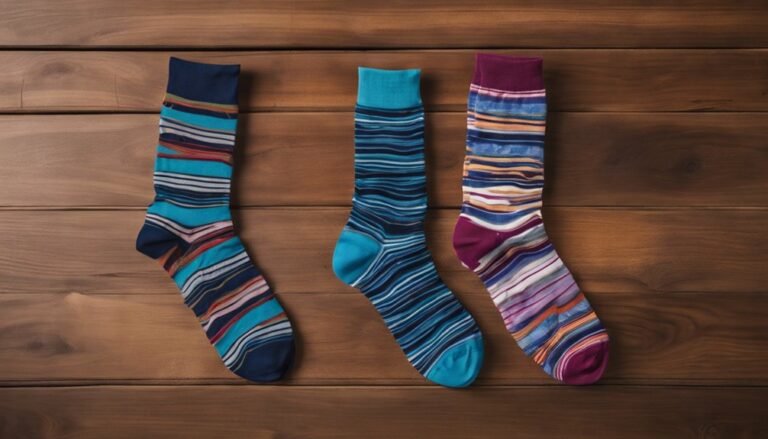Eco-Friendly Socks vs. Recycled Socks: What’s the Difference?
Eco-friendly socks are made from sustainable materials like bamboo or organic cotton, designed to reduce environmental impact through responsible practices. Recycled socks, on the other hand, are created from repurposed textiles, turning waste into new products. Both options prioritize comfort and style but differ in their materials and production processes. If you want to learn more about their environmental benefits and how to choose the right one for your needs, keep exploring!
Understanding Eco-Friendly Socks

When you think about sustainable fashion, eco-friendly socks often come to mind as a practical choice that benefits both you and the planet. These socks are designed with a focus on minimizing environmental impact while maximizing comfort and durability. By choosing eco-friendly options, you're taking a step toward responsible consumerism, promoting a healthier planet. Consumer awareness plays an essential role here; the more you know about the impact of your choices, the better equipped you are to make informed decisions. Eco-friendly socks often come from brands that prioritize ethical production practices and sustainable materials, ensuring your purchase aligns with your values. Embracing this awareness not only enhances your style but also contributes to a movement toward a more sustainable future.
The Materials Used in Eco-Friendly Socks
Eco-friendly socks are crafted from a variety of sustainable materials that prioritize both comfort and environmental responsibility. You'll often find sustainable fabrics like bamboo, hemp, and organic cotton making their way into these innovative designs. Organic cotton is particularly popular, as it's grown without harmful pesticides or synthetic fertilizers, reducing environmental impact. Bamboo, on the other hand, is naturally moisture-wicking and antibacterial, making it perfect for everyday wear. These materials not only feel great against your skin but also support a healthier planet. By choosing eco-friendly socks, you're embracing a lifestyle that values sustainability and freedom from harmful chemicals. So, slip into something that aligns with your values and enjoy the comfort of socks that care for the environment!
Production Processes for Eco-Friendly Socks
When it comes to eco-friendly socks, the production process plays an essential role in their sustainability. You'll find that sustainable material sourcing and eco-conscious manufacturing practices are key components that help reduce environmental impact. By understanding these practices, you can make more informed choices about the socks you wear.
Sustainable Material Sourcing
Sustainable material sourcing plays an essential role in the production of eco-friendly socks, ensuring that the fabrics used are both environmentally responsible and high-quality. By focusing on sustainable sourcing practices, you can enjoy socks that are good for your feet and the planet. Here are three key aspects to reflect on:
- Natural Fibers: Look for socks made from organic cotton, bamboo, or hemp, which reduce chemical use and environmental impact.
- Material Certifications: Check for certifications like GOTS (Global Organic Textile Standard) or OEKO-TEX, guaranteeing environmentally friendly materials.
- Local Sourcing: Supporting local suppliers minimizes transportation emissions and enhances the local economy.
Eco-Conscious Manufacturing Practices
While traditional manufacturing processes can be resource-intensive, eco-conscious practices are transforming the way socks are produced. By prioritizing sustainable fashion, brands are reducing their environmental impact through innovative techniques. This includes using water-efficient dyeing methods and energy-saving machinery that minimizes waste. You'll also find that many companies embrace ethical sourcing, ensuring materials are obtained responsibly and fairly. This not only supports local communities but also fosters a transparent supply chain. When you choose eco-friendly socks, you're not just making a fashion statement; you're embracing a lifestyle that values both quality and sustainability. So, next time you shop, consider how the manufacturing practices behind your socks reflect your commitment to the planet and future generations.
What Are Recycled Socks?
Recycled socks are an innovative solution for those looking to reduce their environmental impact without sacrificing comfort or style. By using recycled materials, these socks promote sock sustainability and help conserve resources. Here are three key benefits of choosing recycled socks:
- Environmental Impact: They minimize waste by repurposing materials that would otherwise end up in landfills.
- Resource Conservation: Using recycled materials reduces the need for virgin resources, conserving water and energy in the manufacturing process.
- Comfort and Quality: Recycled socks can be just as soft and durable as conventional options, providing you with the comfort you love.
The Materials Used in Recycled Socks

When you think about recycled socks, it's important to contemplate the types of materials used in their creation. From post-consumer plastic bottles to leftover fabric scraps, these resources not only help reduce waste but also have a significant impact on the environment. Understanding the manufacturing process behind recycled socks can shed light on their sustainability benefits.
Types of Recycled Materials
Sustainable fashion is gaining traction, and one of its key components is the use of recycled materials in socks. Understanding the types of recycled materials can help you make informed choices. Here's a quick rundown:
- Recycled Polyester: Often derived from plastic bottles, this synthetic blend offers durability while keeping waste out of landfills.
- Recycled Nylon: Sourced from discarded fishing nets and textile scraps, it's a robust option that reduces ocean pollution.
- Biodegradable Fibers: Some socks incorporate natural materials like organic cotton or hemp, which break down more easily, ensuring a smaller ecological footprint.
Environmental Impact of Recycling
Though the process of recycling materials for socks is beneficial, it's essential to understand the broader environmental impact it creates. By choosing recycled socks, you're contributing to waste reduction and enjoying various recycling benefits. However, it's important to be aware of the materials involved, as they can affect the overall sustainability.
| Material | Environmental Impact |
|---|---|
| Recycled Cotton | Reduces water usage considerably |
| Recycled Polyester | Diverts plastic waste from landfills |
| Recycled Wool | Less energy-intensive than virgin wool |
| Blended Materials | Can complicate recycling processes |
Being informed about these materials empowers you to make choices that align with your values and support a healthier planet.
Manufacturing Process Explained
Understanding the materials used in recycled socks provides insight into their manufacturing process and environmental benefits. Recycled socks are crafted from various sustainable innovations that prioritize ethical sourcing. Here's what you can typically expect:
- Recycled Polyester: Often made from plastic bottles, this material reduces waste and energy consumption.
- Organic Cotton: Grown without harmful pesticides, it's a better choice for the environment and your skin.
- Bamboo Fibers: Naturally renewable and biodegradable, bamboo adds softness while being eco-friendly.
Production Processes for Recycled Socks
When you consider the journey of recycled socks, it's fascinating to see how discarded materials are transformed into comfortable, eco-friendly products. The production process typically begins with collecting used textiles, which face sourcing challenges, as not all materials are suitable for recycling. The collected fabrics are sorted, cleaned, and shredded into fibers. These fibers are then spun into yarn, which is woven into socks.
| Step | Description |
|---|---|
| Collection | Gathering discarded textiles |
| Processing | Sorting, cleaning, and shredding |
| Production | Spinning yarn and knitting socks |
This method not only reduces waste but also incorporates recycled content, giving new life to materials that would otherwise end up in landfills. Embracing recycled socks supports sustainability while enjoying comfy footwear.
Environmental Impact of Eco-Friendly Socks
While many people appreciate the comfort of eco-friendly socks, it's important to recognize their significant environmental benefits as well. Choosing these socks supports sustainable fashion and enhances consumer awareness about eco-conscious choices. Here are three key impacts:
- Reduced Waste: Eco-friendly socks are often made from organic materials, minimizing reliance on synthetic fibers that contribute to landfill waste.
- Lower Carbon Footprint: Sustainable production processes typically use less energy and water, leading to a smaller carbon footprint compared to conventional socks.
- Support for Ethical Practices: Many eco-friendly brands prioritize fair labor and environmentally responsible sourcing, promoting a more ethical fashion industry.
Environmental Impact of Recycled Socks

Recycled socks offer an innovative solution to reducing textile waste, as they transform discarded materials into new products. By choosing recycled socks, you're embracing the recycling benefits that help minimize landfill overflow and decrease the demand for new resources. This contributes to sustainable fashion, allowing you to express your style while being environmentally conscious.
The process of recycling old textiles greatly lowers carbon emissions compared to producing conventional socks from raw materials. Plus, it promotes a circular economy where products are repurposed, extending their lifecycle. You're not just wearing socks; you're making a statement about your commitment to a healthier planet. So, when you slip on those comfy, recycled socks, remember you're part of a movement toward a more sustainable future.
Making Informed Choices: Which Sock Is Right for You?
How do you decide which type of sock aligns best with your eco-conscious lifestyle? It's all about balancing sock comfort, sustainability, and your personal fashion choices. Here are a few considerations to help you choose:
- Material: Eco-friendly socks are often made from organic fibers, while recycled socks utilize post-consumer materials. Decide which aligns with your values.
- Comfort: Try both types to see which offers better fit and feel. Comfort can make or break your day!
- Style: Consider how each type complements your wardrobe. Choose socks that express your individuality without compromising your beliefs.
Frequently Asked Questions
Are Eco-Friendly Socks More Expensive Than Regular Socks?
Eco-friendly socks often cost more than regular ones due to their eco-friendly materials and sustainable production methods. However, investing in them supports a greener future, balancing quality and environmental responsibility over time.
Can Recycled Socks Be Composted After Use?
Recycled socks usually aren't compostable due to synthetic materials. If you're considering composting methods, look for socks made from natural fibers like cotton or wool. They'll break down better in your compost pile, giving you eco-friendly options!
How Do I Properly Care for Eco-Friendly Socks?
Caring for your eco-friendly socks is like nurturing a garden; with the right attention, they'll flourish. Use sustainable washing methods and follow sock maintenance tips to keep them fresh, soft, and long-lasting. Enjoy their eco-friendly journey!
Are There Specific Brands Known for Eco-Friendly Socks?
Brands like Bombas and Conscious Step focus on sustainable materials and ethical production. They create stylish, comfy socks while promoting social causes, so you can feel good about your choices and support a better world.
Do Eco-Friendly Socks Come in Various Styles and Colors?
Yes, eco-friendly socks come in a wide style variety and vibrant color options. You'll find everything from casual to dressy designs, ensuring you can express your personality while making responsible, sustainable choices for your wardrobe.







